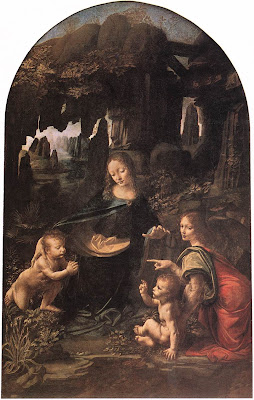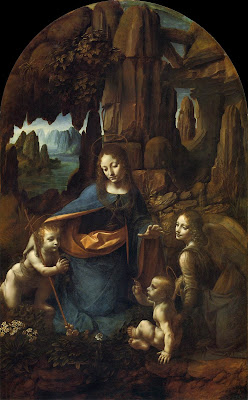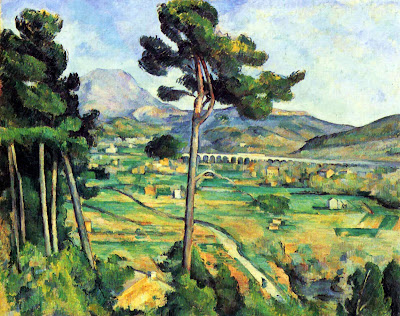The Virgin of the Rocks by Leonardo da Vinci
Leonardo da Vinci
Virgin of the Rocks
1483-86
Oil on panel, 199 x 122 cm
Musée du Louvre, Paris
1483-86
Oil on panel, 199 x 122 cm
Musée du Louvre, Paris
Painting under the model of sculpture, more specifically, under the model of relief sculpture, is an idea stated and restated in the Renaissance by, among others, Leonardo and Michelangelo: bodies must appear as if detached from the support, wall, panel or canvas. Leonardo develops to new levels Masaccio’s sculptural and atmospheric effects through the play of light on solid bodies and on space.
The tangible and the insubstantial, bodies and light, matter and energy, are fused in the self-conscious, thorough and methodical pursuit of atmospheric effects of color and shading in, for instance, the Virgin of the Rocks, painted by Leonardo in 1483.
A groundbreaking work, the Virgin of the Rocks presents seminal elements of Leonardo’s art that reappear, that is, are reworked and further developed at different stages of his career, and will be also influential in the development of other Renaissance artists.
Among these elements are: the prototypical ideal feminine image developed from his early studies in the workshop of Verrocchio and under the influence of Leonardo’s master; the attentive record of the natural world, reflecting both the analytical and empirical mind of the scientist and researcher, an objective and somewhat detached scrutiny, collection and replication of the forms of reality, and the individual empathy or identification with all that is living, with the rhythms of nature and the cyclical processes encompassing all the natural world , from rock, to plants and animals, unified into a quasi-pantheistic vision of the universe as a living , communicating organism, of which man is but a part; the body in action as a significant substance within the visible play of the signifying process , that is, the depiction of a gestural language marking the expressive unity of our corporeal selves, that is the unity of the body and the soul or spirit.
In the Virgin of the Rocks, the sense of form has indeed, in the somewhat exhaustive depictions of bodies and surfaces, an intense tactile quality. At the same time, this proximity of matter is balanced by the effects of air, that is, by atmospheric perspective, that envelopes and modifies the colors, forms and relative weights of figures and things, organizing their relative positions and reciprocal interactions within an ordered and dynamic totality. Light and atmosphere will soften the hardness of matter, will lessen and mitigate the rigidity of outlines, and produce a dialogue of colors in subtle vibrations, as a kind of "music" or "poetry" of forms and tones. The tangible and the intangible are fused within the recurrent, cyclical exchanges encompassing all reality in a play of mirrors, in which matter and the spirit balance and reflect each other in isonomic relations.
Whit the Virgin of the Rocks and its pyramidal composition that groups the figures and coordinates their communicative exchanges and gestures, Leonardo creates a new type of representation of the Madonna that will form the stylistic and compositional basis of Raphael’s paintings of the subject, minus what we can call the Mercurial element of Leonardo’s work, that is, the more somber emotive tonalities that emerge, here and there, in more or less subtle ways in Leonardo’s paintings.
In the Alba Madonna, for instance, as in the Madonna del Prato, Raphael will transform the atmospheric play of contrasts of Leonardo’s works into a kind of Mediterranean clarity of light and color, infusing the sacred representation with a joyous and serene expression of a type of everyday contentment of motherhood.
A groundbreaking work, the Virgin of the Rocks presents seminal elements of Leonardo’s art that reappear, that is, are reworked and further developed at different stages of his career, and will be also influential in the development of other Renaissance artists.
Among these elements are: the prototypical ideal feminine image developed from his early studies in the workshop of Verrocchio and under the influence of Leonardo’s master; the attentive record of the natural world, reflecting both the analytical and empirical mind of the scientist and researcher, an objective and somewhat detached scrutiny, collection and replication of the forms of reality, and the individual empathy or identification with all that is living, with the rhythms of nature and the cyclical processes encompassing all the natural world , from rock, to plants and animals, unified into a quasi-pantheistic vision of the universe as a living , communicating organism, of which man is but a part; the body in action as a significant substance within the visible play of the signifying process , that is, the depiction of a gestural language marking the expressive unity of our corporeal selves, that is the unity of the body and the soul or spirit.
Andrea del Verrocchio, Head of a Woman
(recto & verso ), c. 1475,
charcoal , heightened with lead white, pen and brown ink (r.),
charcoal (v.),
324 x 273 mm., British Museum
(recto & verso ), c. 1475,
charcoal , heightened with lead white, pen and brown ink (r.),
charcoal (v.),
324 x 273 mm., British Museum
In the Virgin of the Rocks, the sense of form has indeed, in the somewhat exhaustive depictions of bodies and surfaces, an intense tactile quality. At the same time, this proximity of matter is balanced by the effects of air, that is, by atmospheric perspective, that envelopes and modifies the colors, forms and relative weights of figures and things, organizing their relative positions and reciprocal interactions within an ordered and dynamic totality. Light and atmosphere will soften the hardness of matter, will lessen and mitigate the rigidity of outlines, and produce a dialogue of colors in subtle vibrations, as a kind of "music" or "poetry" of forms and tones. The tangible and the intangible are fused within the recurrent, cyclical exchanges encompassing all reality in a play of mirrors, in which matter and the spirit balance and reflect each other in isonomic relations.
Whit the Virgin of the Rocks and its pyramidal composition that groups the figures and coordinates their communicative exchanges and gestures, Leonardo creates a new type of representation of the Madonna that will form the stylistic and compositional basis of Raphael’s paintings of the subject, minus what we can call the Mercurial element of Leonardo’s work, that is, the more somber emotive tonalities that emerge, here and there, in more or less subtle ways in Leonardo’s paintings.
In the Alba Madonna, for instance, as in the Madonna del Prato, Raphael will transform the atmospheric play of contrasts of Leonardo’s works into a kind of Mediterranean clarity of light and color, infusing the sacred representation with a joyous and serene expression of a type of everyday contentment of motherhood.
Raphael,
Madonna of Belvedere
(Madonna del Prato)
1506
Oil on wood, 113 x 88 cm
Kunsthistorisches Museum, Vienna
Madonna of Belvedere
(Madonna del Prato)
1506
Oil on wood, 113 x 88 cm
Kunsthistorisches Museum, Vienna
In the Virgin of the Rocks, the scene is set against the background of a corner of wild nature, a grand depiction of a deserted, inhospitable or indifferent nature. The cave and the waters allude both to geological time and processes, to Leonardo’s early depictions of rocky river banks of his native Tuscany, and to the symbolism of the womb as the source of life. Growth and form are central themes in Leonardo's art and in his quest for knowledge. Mary, the mother of Christ, is the central figure in the composition. The young Saint Mary tenderly protects Jesus and Saint John assisted by the archangel Gabriel, who engages by his direct gaze and gesture the spectator, and invite us to look and participate on the warmth and significance of the human and divine exchanges between the main characters. The dark cave in the background also alludes to the catacomb, the underground burial site of early Christianity, in a complex association of the encounters between the infants Saint John the Baptist, the prophet who first recognized the living Messiah, and Jesus, (the subject of the painting is an original concept by Leonardo) prefiguring the martyrdom of the Christ: the passion, death and rebirth of Jesus as the rebirth of the soul of man in the light of divine revelation and the fulfillment of the Christian prophesy.
Leonardo da Vinci
Virgin of the Rocks (detail)
1483-86
Oil on panel, 199 x 122 cm
Musée du Louvre, Paris
1483-86
Oil on panel, 199 x 122 cm
Musée du Louvre, Paris
We can point out that The Virgin of the Rocks anticipates Mona Lisa, a portrait also of the ideal, "eternal" or "ancestral" feminine in modern guise, also painted against a background of a deserted landscape of rocky mountains and rivers. As understood by some of the Romantic interpreters of Leonardo in the late 19th century, in the Mona Lisa we see a representation of the “ages of the world” as a kind of genealogy of the earth (and of all the living, of the universe itself as a type of supra-organism , a system of systems), expressing the "question of origins" in the quotidian "mystery " of the woman. Since the times of Vasari, the Mona Lisa was (and in many ways still is) the Renaissance emblem of painting.
Marcelo Guimaraes Lima
Leonardo da Vinci
Mona Lisa (La Gioconda)
c. 1503-5
Oil on panel, 77 x 53 cm
c. 1503-5
Oil on panel, 77 x 53 cm
Musée du Louvre, Paris
Leonardo da Vinci
Virgin of the Rocks
1495-1508
Oil on panel, 189,5 x 120 cm
National Gallery, London
Virgin of the Rocks
1495-1508
Oil on panel, 189,5 x 120 cm
National Gallery, London
Images source: http://www.wga.hu/index.html










Comments